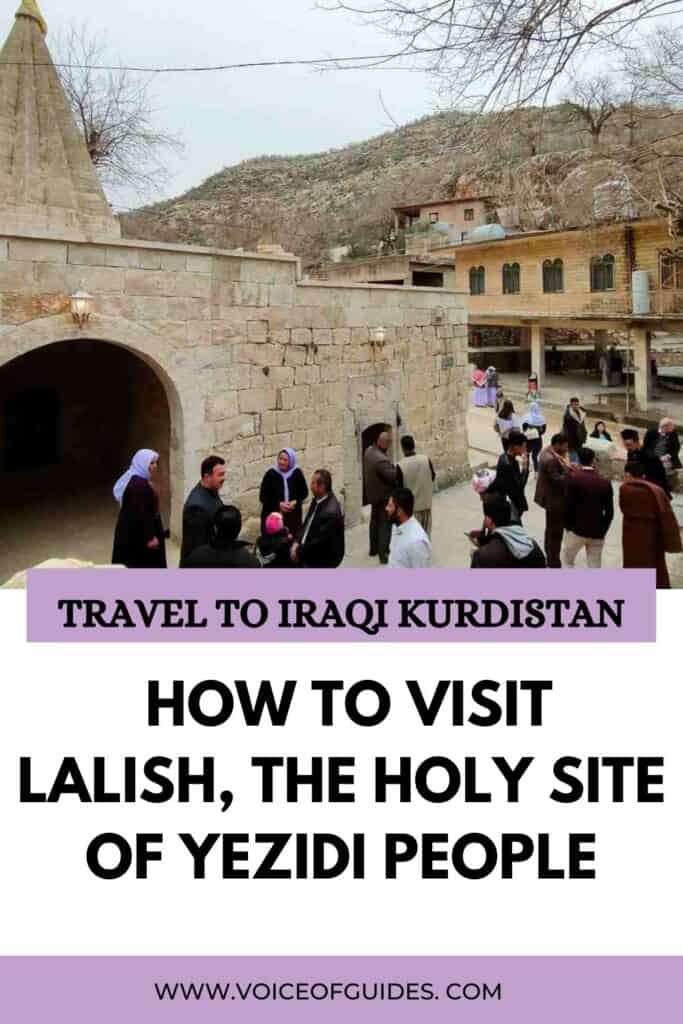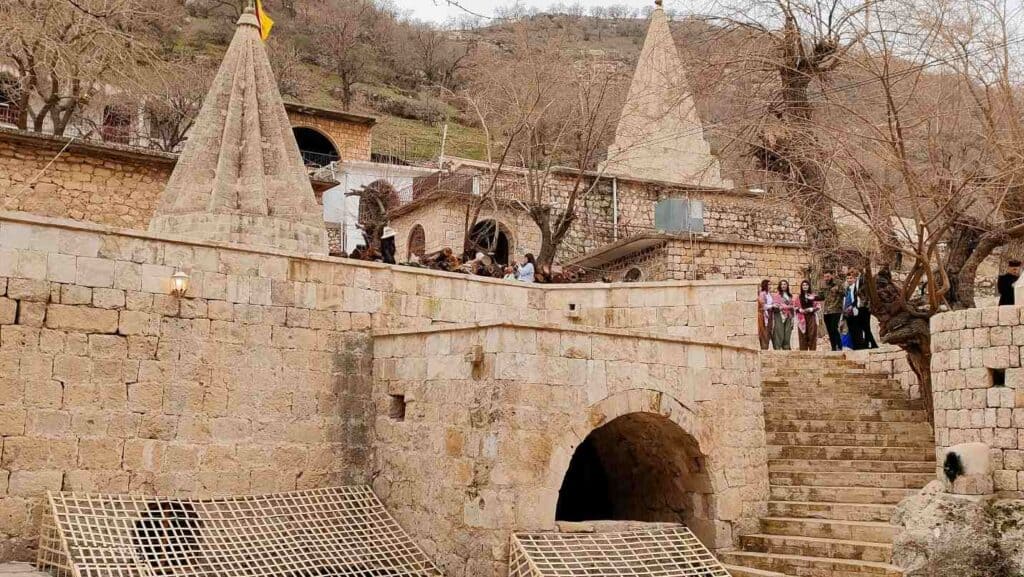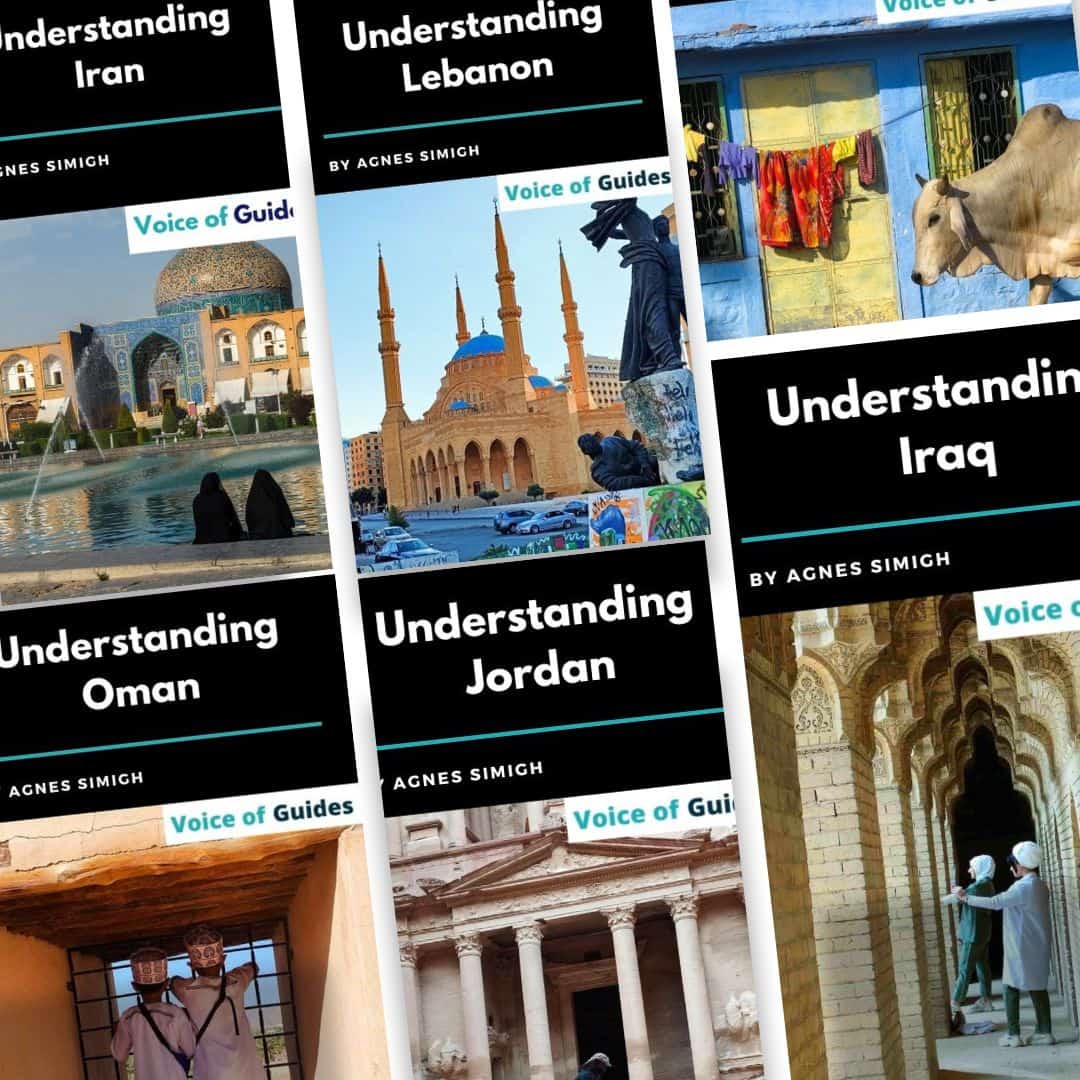This article may contain affiliate / compensated links. For full information, please see our disclaimer here.
Lalish is the holiest site for the followers of the Yezidi religion that you must include in your Iraqi Kurdistan itinerary. Yezidi people have their own religious sect for which they have been persecuted and harassed for centuries. They were the most vulnerable to the Islamic State’s brutality as well. Despite hardships, Yezidis strive to maintain their religion. In this travel guide, you find all the necessary information about visiting Lalish, including what you need to know about the Yazidi faith, people and the rules to visit their main temple.
- How to get to Lalish?
- What is the best time for visiting Lalish?
- How to visit Lalish, the most important Yazidi temple in Iraq
- What you should know about Yezidi people and religion
- Yazidi people’s life during ISIS
- Books to read about Yazidi people
- Other articles about Iraq
- More articles about the Middle East
- Pin it for later!
How to get to Lalish?
Lalish is the name of the valley and temple in the north of Iraqi Kurdistan that you can reach from the Iraqi Kurdish cities of Erbil and Duhok or Mosul in Federal Iraq. Your visa to Federal Iraq is also valid for the autonomous Iraqi Kurdish region. However, if you arrive in Iraqi Kurdistan, you are only permitted to travel within this region, and you cannot go to Mosul.
The Lalish temple is 60 kilometers north of Mosul and 14 kilometers west of Ayn Sifna village. You need to arrange a private taxi from Mosul, Duhok or Erbil as there is no public transport or shared taxi.
Visiting Lalish and Alqosh with the Rabban Hormizd monastery is a perfect one-day trip from Mosul.
Check this detailed travel guide about visiting Mosul
What is the best time for visiting Lalish?
The best time to go to Lalish and, in general, to Iraqi Kurdistan is from March to October, though early spring and late autumn can still be colder. Iraqi Kurdistan is mountainous; during winter, the temperature drops, and there can be heavy snowfall.
However, its higher elevation is ideal even when scorching heat hits Baghdad and the south of Iraq. During this time, many Iraqis come for some refreshment to the Kurdish region and to enjoy the greenery that the deserted southern part completely lacks.
“Feast of Assembly” in October
The best time to visit Lalish is during the “Feast of Assembly” in October, the annual week-long festival when most Yezidi pilgrims arrive to honor Sheikh Adi. They also celebrate the day Malak Tawus descended to earth and since then connected mankind to heaven. It is the most important period for Yezidi people and, thus, the best time for visiting Lalish to have an authentic cultural experience.
During this period, all the tribal chiefs and religious leaders come together, and you can witness a range of celebrations, public feasts, candle lightings, animal sacrifices, and particular rituals pilgrims traditionally complete. Apart from the tomb of Sheikh Adi, they visit other sacred places.
The Bridge of Silat is another sacred spot symbolizing the transition from earthly to heavenly life. Here pilgrims remove their shoes and wash their hands before crossing it and heading to Sheikh Adi’sAdi’s tomb. They also approach a sacred white stone on the nearby Arafat Mountain.
Insurance: Safetywing is a cheap travel and medical insurance that also covers COVID-related issues in most countries, including Iraq.
Flights: Use Google Flights or Skyscanner to book your flight to get the best flight offers.
The evening dance of the priests and the bull sacrifice are the two most important events during the festival. The sheikhs dress up every evening in white (symbolizing purity) after sunset and perform a ritual dance in the courtyard accompanied by music.
On the 5th day, they sacrifice a bull in the shrine they regard as holy divine. Yezidis pray for substantial rain for the coming winter and spring. The bull is set free inside the shrine that men chase up to the nearby mountain, catching and slaughtering it. After that, they prepare the meat and serve it to the pilgrims.
New Year in April
The New Year celebration in April (also called Çarşema Sor “Red Wednesday”) is another great time to go to Lalish. They color eggs and sacrifice a sheep while the lit torches illuminate the entire Lalish valley, bake festival bread (sawuk), visit the grave of family members, offer sacrifices, and expect to get blessings. Then they head to the neighboring mountains to tie colorful ribbons on wishing trees. It is also the time when family and friends gift each other.
How to visit Lalish, the most important Yazidi temple in Iraq
Lalish is a historic town that ancient Sumerians are believed to have used already thousands of years ago. In the 19th century, various Muslim tribes attacked and looted it during Ottoman rule and even converted it into a Quranic school. At the beginning of the 20th century, they managed to retake it and expel the Muslims from the holy site. However, apart from the Emir, the chief of the religion, nobody lives there. They offer these empty houses to pilgrims as temporary accommodation.
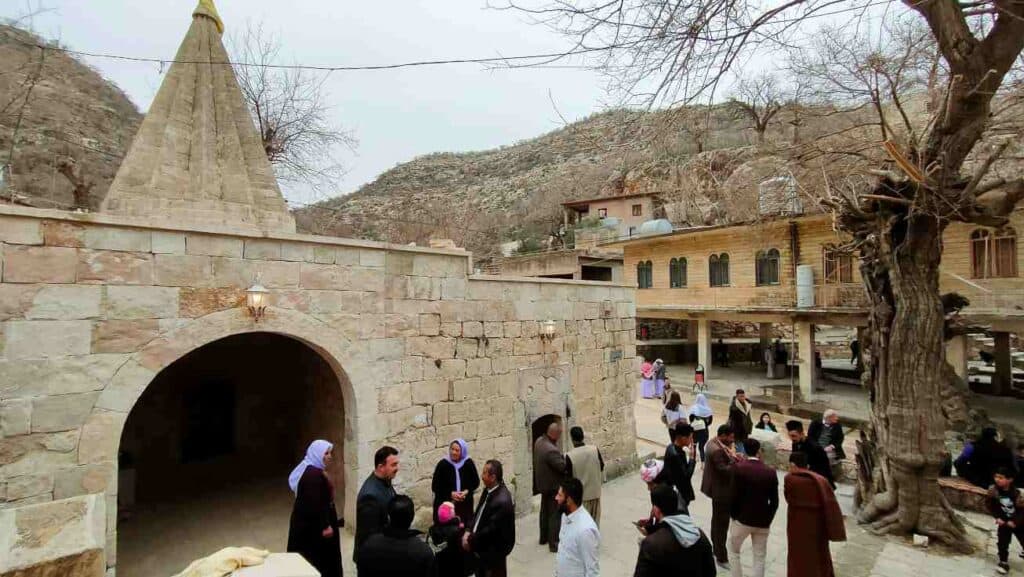
This is the holiest site of the Yazidi people because it houses the tomb of Sheikh Adi ibn Musafir, the chief saint of the Yazidi faith. Sheikh Adi was born in the Beqaa valley of today’s Lebanon. He was a disciple of a Muslim mystic, visited Mecca, and chose to live an ascetic life. Finally, the religious scholar moved from Baghdad to Lalish, where his increasing number of followers settled close to him. Despite adhering to the script of the holy book, the Quran and the Sunnah, he was a respected Sufi scholar and one of the first to pursue ascetic life. Sheik Adi died in 1162 in his hermitage in Lalish and has since been respected as the biggest Yazidi saint.
Every Yazidi people wants to undertake the pilgrimage to Lalish once in his life. They visit other holy places besides the sheikh’s tomb, like the Zamzam (sacred spring). The Zamzam is inside the shrine in a separate cave that only Yezidis can enter. This White Spring runs through Lalish and fills marble cisterns where Yezidi people get baptized.
Many Yezidi pilgrims take some soil from Lalish that they wrap up in a small cloth folded into a triangle. They keep it in their wallet and pocket as a talisman for protection.
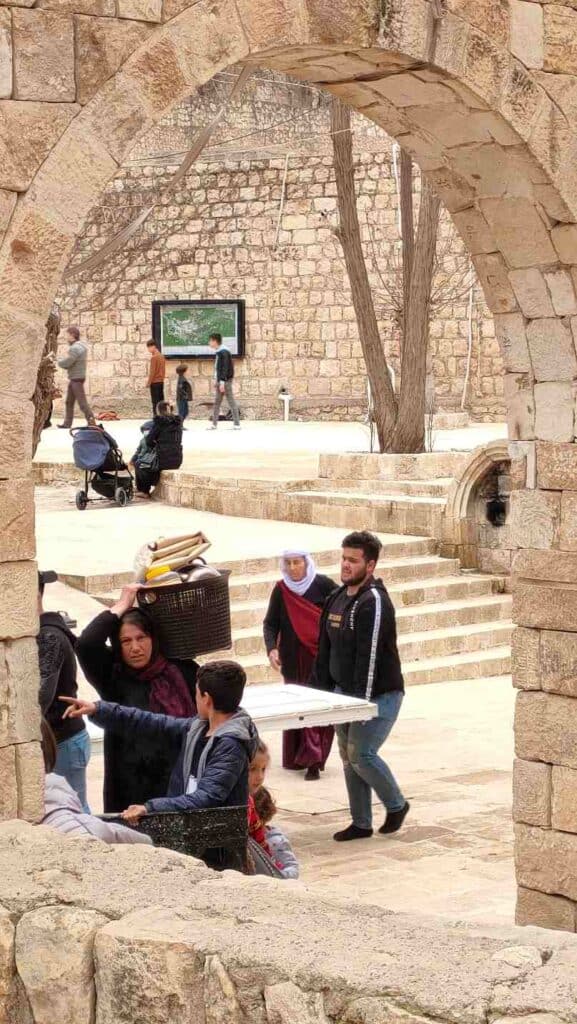
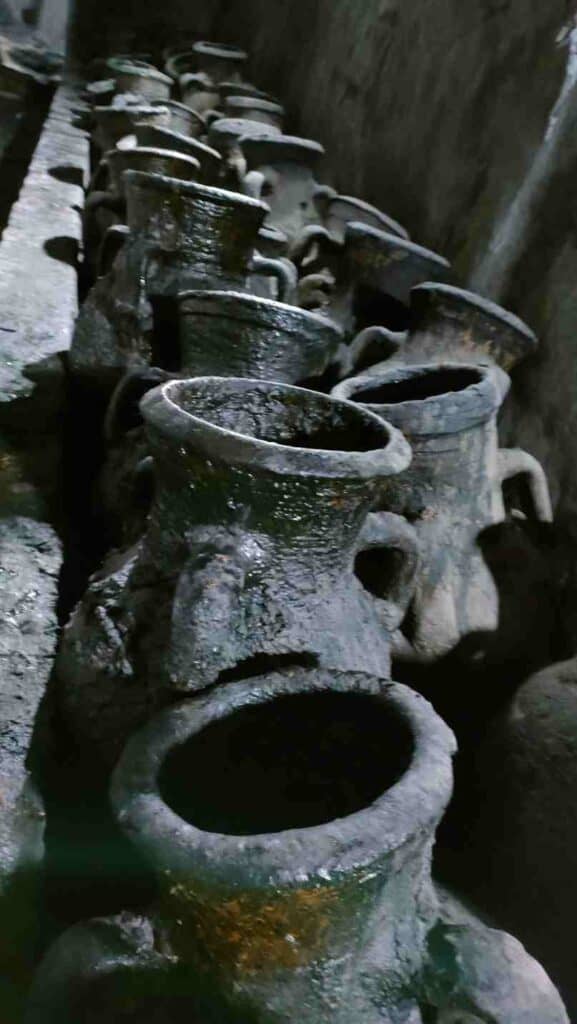
The holy Yezidi site, Lalish, is a temple complex consisting of several shrines with conical roofs and temples decorated with Yezidi symbols (the Sun, the black serpent, and the peacock). It has cave formations with water pools that date back to 512BC.
Inside the temples, they tie colorful silk into knots, each representing a wish and a prayer. The tomb of Sheikh Adi is the holiest place inside the complex. Its entrance is adorned with a black stone snake, considered an auspicious creature by Yezidis.
A big dark stone chamber contains clay jars filled with olive oil made from the olives of the neighboring hills. They use this oil for religious rituals and to burn lamps that blacken the entire surface.
Every day a group of volunteers cleans and maintain the temple complex and light lamps.
Important things to know about visiting Lalish as a traveler
You must remove your shoes and walk barefoot from the parking lot, even through the streets. The ground is considered holy as this was where Malak Tawus, the Peacock Angel, first descended to the earth to bring order from chaos.
Since Yezidis kiss the door frames and doorsteps of temples before entering, avoid stepping on the doorstep.
What you should know about Yezidi people and religion
Yezidi people
There are around 1 million Yezidi people scattered all around the world due to persecution. In Iraq, most of them live in the Nineveh plain area. The Yezidi belief preserves elements from Christian, Jewish, Muslim, and even Zoroastrian religions. Yezidis have always been one of the most disadvantaged people in Iraq. Most of the Yazidi traditions are passed orally, which makes them mysterious and helps to keep them secret.
The Yezidi community is closely connected to the Iraqi Kurdish people. Most of them speak the Kurmanji dialect of Kurdish as their first language, some of them Arabic. But they are a separate ethnic group with a unique religion and strict traditions. Due to their beliefs, they are stigmatized as infidels and heathens. They have been subject to genocide and harassment throughout history during the Ottoman Empire for centuries and during Saddam as well. They often face discrimination in Iraqi society by being refused to get jobs or visiting Lalish.
President Saddam often tried to get their support against the Kurdish community and wanted that the Yezidis pledge alliance to his Baath party and change their ethnicity to Arab. In return, he opened the first schools for Yezidis, and they could freely practice their religion.
After the US invasion of 2003, they took the side of the Americans as they promised work, freedom and security. Many Yezidi men became translators or took jobs with the Iraqi or American armies.
Their situation improved because they could take jobs as guards and policemen or work in one of the new hotels and restaurants in Erbil. The Americans systematically removed the Baathists from their positions, leaving the privileged members of the Saddam era powerless and jobless, thus creating a disgruntled mass.
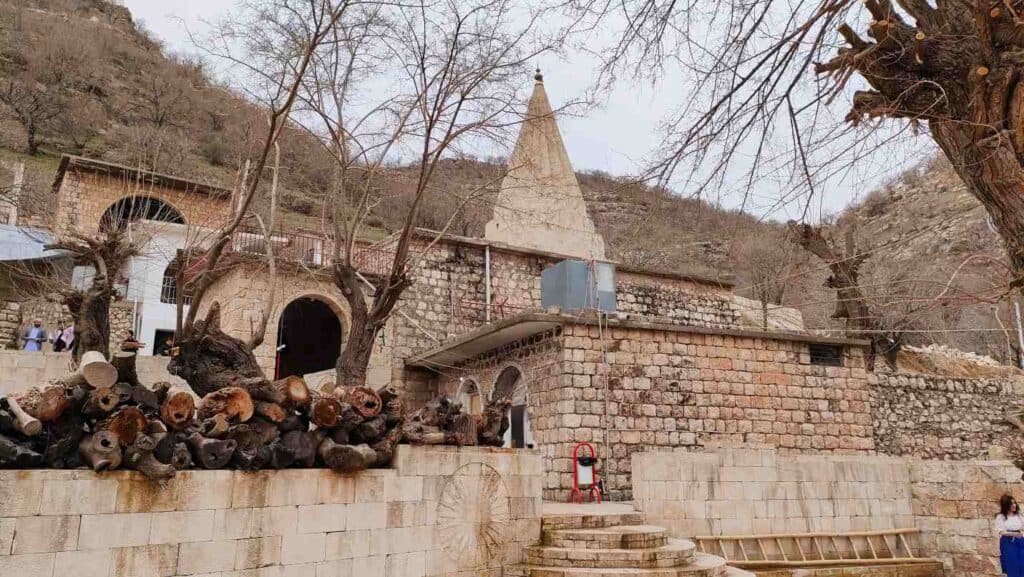
Yezidis were continuously pushed to give up their religion and choose Kurdish or Arab identity. Despite persecution and massacre, they try to maintain their faith, and incidents against Yezidis have happened until today.
The Iraqi history books taught in school do not mention them, making their religion harder to acknowledge and respect by other Iraqis.
They have a Baba sheikh (Father priest) as religious and Mir (Prince) as a secular leader. They both belong to the upper sheikh caste, whose members are believed to be the descendants of one of the six angels that accompanied Malak Tawus. During important religious events, the Baba Sheikh comes to Lalish and gives the pilgrims blessings, assisting at weddings, funerals, and baptisms.
Yezidis can have up to 7 wives, but marrying outside the community is not allowed. This is how they want to protect the community from extinction. It seems an extremely hard task as Yazidis have fled in great numbers and settled in Germany, Canada, or the United States, where younger generations are more inclined to lose connection to their religion.
Yezidi faith and religion
Yezidis believe in one God, who entrusted seven angels to rule the universe. Malak Tawus (Melek Taus), the “peacock angel”, is the most divine of all of them, and he is God’s connection to the earth. Yezidis often decorate their home with peacock symbols and pray to him directly, which enrages orthodox Muslims.
Once Malak Tawus descends to earth, he meets Adam, who was created to be immortal and sinless. Since Adam is to be reproduced, according to the angel, he should not possess these divine attributes. So, he convinced Adam to eat wheat, which God forbade him to do. This is how Adam gets expelled from paradise, and the second generation of Yazidis are born into the world. Orthodox Muslims identify Malak Tawus with the devil figure in the Quran who defied Adam and God and thus call the Yezidi devil worshippers.
Yezidis believe that Malak Tawus appeared on earth on a Wednesday. This is a holy day and the day of rest for the Yezidis. Some don’t shower on this day.
They pray towards the sun every morning at dawn, Lalish during the day, and the moon at night. To the Yazidi, every element—earth, wind, water, sunlight, and fire—is sacred. But above all, feeling the sun’s rays is like standing before the eye of God’s first angel, Malak Tawus.
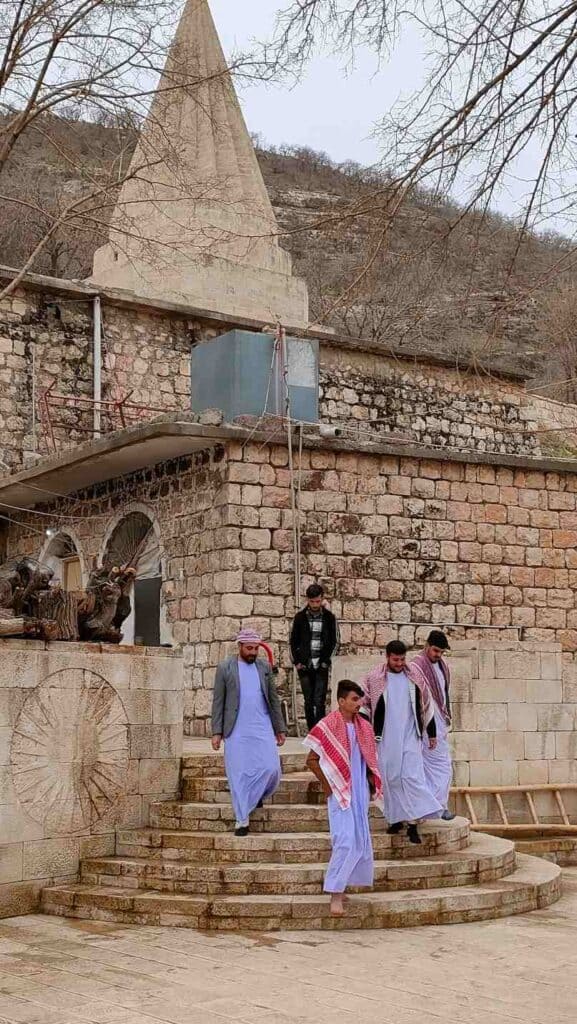
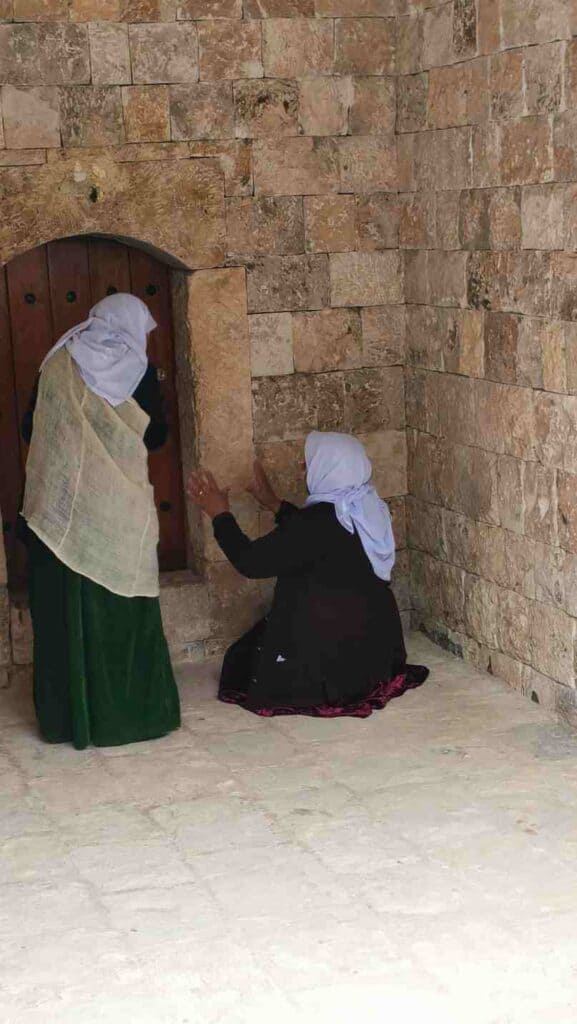
For that, they are called pagans. Prayers are accompanied by particular gestures, like kissing the red and white bracelet that many Yazidi women and men wear around their wrists or, for a man, kissing the collar of his traditional white undershirt.
Another cardinal difference in the Yezidi faith is that they believe in reincarnation. People often make fun of their strange habits, such as not eating lettuce, not wearing blue, the color of the peacock angel, etc. All that is enough for some to justify genocide against the Yezidis.
Yezidis believe they have to live as righteous persons on earth to deserve to be reborn through reincarnation. It means they refrain from violence and any hostile behavior. This makes them also overly vulnerable to any attack. They don’t want to expand their territories or convince anybody to convert because nobody cannot anyway.
Dead people must be buried properly, and the family has to perform all the expected rituals and prayers. Without that, the soul will never be reborn. Yezidi people mourn long. Weddings get canceled, and women change their white dresses to black. Family members and neighbors retreat from life.
Conversion to another religion is considered a betrayal by the Yezidi community. This is also because, for so many centuries, they were forced to do that to save their lives.
The “Black Book” is the main religious text of the Yezidi people that was written by Sheikh Adi, who is considered the reincarnation of Malak Tawus.
Yazidi people’s life during ISIS
The Yezidi community has suffered over 70 genocides since its existence, but ISIS stepped up with unparalleled cruelty against them.
The “Research and Fatwa Department” of ISIS stated that Yezidi people are non-believers (kuffar) who don’t have a real holy book like Christians and Shias. It means that enslaving and raping them does not qualify as a sin. Christians and Shias were offered to pay a fine to keep their religion or were allowed to bring their family to Kurdistan, but not the Yezidis.
Most Yezidi people lived on the slopes of Sinjar Mountain, 130 km to the west of Mosul in federal Iraq and 60 km from the Iraqi Syrian border. The Sinjar range is sacred for Yezidis, who believe that this is where Noah’s Arc first touched earth after the biblical flood. It was also a shooting scene for the film, The Exorcist.
In 2014, Sinjar was encircled by ISIS and gave an ultimatum: convert to Islam or die. At least 130,000 refugees fled from Sinjar to Duhok or Erbil.
Insurance: Safetywing is a cheap travel and medical insurance that also covers COVID-related issues in most countries, including Iraq.
Flights: Use Google Flights or Skyscanner to book your flight to get the best flight offers.
Under the Iraqi Constitution, the Kurdish Peshmerga military groups must defend the Yezidis, which did not happen. Tens of thousands were marching through the Sinjar mountains to Iraqi Kurdistan through the Kurdish part of Syria. Many died during the march in the Sinjar mountains from starvation or dehydration. The US ordered bombings and dropped water and food from the air for those trapped in the mountains to avoid genocide.
Some stayed in the mountains in refugee camps as they refused to live in their homeland, Sinjar. The Kurds helped the Yezidis on their way by giving them food and shelter. In the meantime, ISIS confiscated and looted their homes and took their cars and animals.
Young women were traded like property and sold as sabayas (sex slaves) among ISIS militants in Iraq and Syria. Being raped was the most humiliating for Yezidi women, some of whom preferred committing suicide. They were forced to convert to Islam and “marry” ISIS militants. Official papers were filled and signed about which girls belonged to which militant. Some ISIS wives assisted the safe escape of Yezidi women, while others were worse than men.
Many Yazidis who fled their homes found refuge in Lalish, arriving in a physically and mentally destroyed state. Due to the conservative Yezidi traditions, many women had doubts about how their families welcomed them back home. They were no longer virgins and were converted into Islam, even all that by force. Unfortunately, some families refused their women, although the religious dignities declared that women are innocent as it happened not of their own will. Many survivors underwent “re-virginization” surgery, repairing the hymen in the hope of erasing the memory and the stigma of the rape.
The UN officially recognized what ISIS did to the Yazidis as a genocide.
Life in the refugee camps was hard. Men had no work, their wives, sisters, and mothers were in captivity, and their brothers and fathers were dead. They were absorbed by mourning their missing family members and the lost ones.
Books to read about Yazidi people
Nadia Murad: The Last Girl: My Story of Captivity and My Fight Against the Islamic State
Jeffrey Shaker: Shadow on the Mountain: A Yazidi Memoir of Terror, Resistance and Hope
I hope you found this travel guide about visiting Lalish helpful and gives you an insight into the Yezidi religion and life at the same time. It helps you understand the holiest site of the Yezidis, Lalish, nestled in beautiful surroundings in the mountains of Iraqi Kurdistan. Whether you travel around Iraq or Iraqi Kurdistan, you should not miss visiting Lalish with its unique ambiance.
Other articles about Iraq
All you need to know before traveling to Iraq
What to visit in Baghdad in 3-4 days
The best books to read about Iraq (constantly updated)
More articles about the Middle East
Lebanon
10-day itinerary to visit Lebanon
How to spend 2-3 days in Beirut
Travel guide to Tripoli, Lebanon
Best books to read about Lebanon
Traveling around Lebanon during the economic crisis
Iran
What you can and cannot do in Iran
45 things you must know before traveling to Iran
The best books to read about Iran
The best 2-week itinerary in Iran (the classical route)
All you need to know about the Iranian currency
The best places to visit in Tehran (museums, palaces, religious sites)
The best things to do in Tehran
Travel guide to Tabriz, North Iran
Travel guide to Mashhad, the holy city of Iran
Best things to do in Lahijan, the city of tea in Iran
Best things to do in Ramsar at the Caspian Sea
Visit Varzaneh desert, Toudeshk, Mesr desert and Garmeh from Isfahan
Varzesh-e Bastani, more than a sport
Amazing Iranian hospitality: my experience as solo female traveler in Iran
All you need to about the Iranian currency, the Rial
Jordan
The perfect Petra one and two-day itinerary in Petra
Visiting Jerash, Ajloun and Umm Qais
Jordan desert castles: a day trip from Amman
5, 7 and 10 day Jordan travel itineraries
All you need to know before planning a trip to Iran
Pin it for later!
